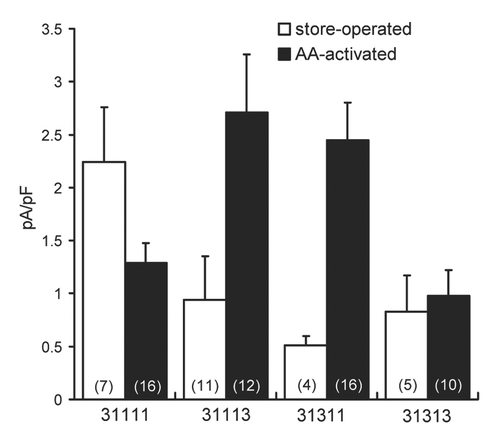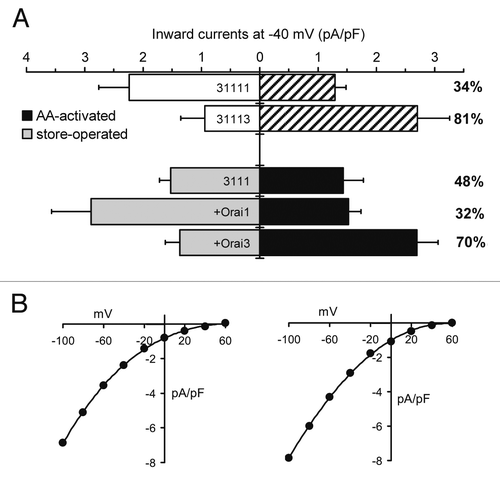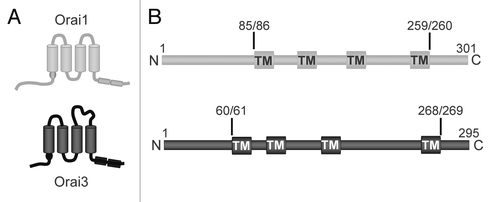Figures & data
Figure 1 The effect of expression of different Orai1/Orai3 pentameric constructs on store-operated and arachidonic acid activated currents. Inward store-operated currents (white bars) and arachidonic acid activated currents (black bars) measured at −40 mV in STIM1-stable cells expressing different concatenated pentameric constructs containing various numbers of Orai3 subunits. Values are means ± SEM, n = numbers in parentheses.

Figure 2 The effect of co-expression of a 3111 tetramer with either an Orai1 monomer or an Orai3 monomer on store-operated and arachidonic acid activated currents. (A) Inward currents measured at −40 mV recorded in STIM1-stable cells on expression of the 3111 tetramer alone or in combination with either an Orai1 monomer or an Orai3 monomer. Shown are the store-operated currents (white or grey bars) and arachidonic acid activated currents (crosshatched or black bars). The numbers to the right represent the calculated percent of the total recorded increased current that is sensitive to activation by arachidonic acid. Also shown for comparison are the corresponding values recorded on expression of the concatenated 31111 and 31113 pentamers (data taken from ). Values are means ± SEM, with values of n for store-operated and arachidonic acid activated equal to 15 and 9 (3111 tetramer), 12 and 12 (tetramer plus Orai1) and 9 and 9 (tetramer plus Orai3), respectively. (B) Representative curves of the current-voltage relationship for the store-operated current seen on co-expression of the 3111 tetramer and the Orai1 monomer (left), and the arachidonic acid activated current on co-expression of the 3111 tetramer and the Orai3 monomer (right).

Figure 3 Comparison of the structure and sequences of Orai1 and Orai3. (A) Diagrams comparing the basic structural differences between the Orai1 and Orai3 molecules. (B) Linear representation of the structure of Orai1 (grey) and Orai3 (black) showing the key positions in the sequence where chimeras and/or deletion mutants were generated. The location of the transmembrane domains are indicated (TM).

Figure 4 The effect of co-expression of a 3111 tetramer with various Orai1/Orai3 chimeric monomers on store-operated and arachidonic acid activated currents. (A) Diagrams illustrating the basic composition of the various Orai1/Orai3 chimeric monomers examined. Components from Orai1 are represented in grey, whilst those from Orai3 are in black. (B) Inward currents measured at −40 mV recorded in STIM1-stable cells on expression of the 3111 tetramer with the various Orai1/Orai3 chimeric monomers indicated in (A) above. Other information as in . Shown for comparison are the corresponding values recorded on expression of the 3111 tetramer alone, and 3111 tetramer co-expressed with the intact Orai3 monomer (data taken from ). Values are means ± SEM, with values of n for store-operated and arachidonic acid activated equal to 17 and 12 (tetramer plus [113]), 12 and 9 (tetramer plus [131]), 14 and 13 (tetramer plus [311]), 12 and 16 (tetramer plus [331], and 6 and 10 (tetramer plus [313]), respectively. (C) Representative curves of the current-voltage relationship for the store-operated current (grey) and the arachidonic acid activated current (black) seen on co-expression of the 3111 tetramer with the [113] chimeric monomer (top), the [131] chimeric monomer (middle), and the [311] chimeric monomer (bottom).
![Figure 4 The effect of co-expression of a 3111 tetramer with various Orai1/Orai3 chimeric monomers on store-operated and arachidonic acid activated currents. (A) Diagrams illustrating the basic composition of the various Orai1/Orai3 chimeric monomers examined. Components from Orai1 are represented in grey, whilst those from Orai3 are in black. (B) Inward currents measured at −40 mV recorded in STIM1-stable cells on expression of the 3111 tetramer with the various Orai1/Orai3 chimeric monomers indicated in (A) above. Other information as in Figure 2. Shown for comparison are the corresponding values recorded on expression of the 3111 tetramer alone, and 3111 tetramer co-expressed with the intact Orai3 monomer (data taken from Fig. 2). Values are means ± SEM, with values of n for store-operated and arachidonic acid activated equal to 17 and 12 (tetramer plus [113]), 12 and 9 (tetramer plus [131]), 14 and 13 (tetramer plus [311]), 12 and 16 (tetramer plus [331], and 6 and 10 (tetramer plus [313]), respectively. (C) Representative curves of the current-voltage relationship for the store-operated current (grey) and the arachidonic acid activated current (black) seen on co-expression of the 3111 tetramer with the [113] chimeric monomer (top), the [131] chimeric monomer (middle), and the [311] chimeric monomer (bottom).](/cms/asset/48f16fc1-82bd-4f5f-8383-4ee45d73ded7/kchl_a_10913226_f0004.gif)
Figure 5 The effect of co-expression of a 3111 tetramer with various N-terminal deletions or chimeras of Orai1/Orai3 monomers on store-operated and arachidonic acid activated currents. (A) Diagrams illustrating the basic composition of the various N-terminally modified Orai1/Orai3 monomers examined. Again, components from Orai1 are represented in grey, whilst those from Orai3 are in black. (B) Inward currents measured at −40 mV recorded in STIM1-stable cells on expression of the 3111 tetramer with the various N-terminally modified Orai1/Orai3 monomers indicated in (A) above. Other information as in . For comparative purposes, the corresponding values recorded on expression of the 3111 tetramer alone, and 3111 tetramer co-expressed with the either intact Orai3 monomer or the intact Orai1 monomer are also shown (data taken from ). Values are means ± SEM, with values of n for store-operated and arachidonic acid activated equal to 6 and 5 (tetramer plus [X11]), 7 and 5 (tetramer plus [X33]), 6 and 6 (tetramer plus [(1/3)11]), and 8 and 6 (tetramer plus [(3/1)11]), respectively. (C) Representative curves of the current-voltage relationship for the store-operated current (grey) and the arachidonic acid activated current (black) seen on co-expression of the 3111 tetramer with either the N-terminally-deleted Orai1 monomer [X11] (top left), or the corresponding N-terminally-deleted Orai3 monomer [X33] (top right), and the N-terminal chimeric monomers, [(1/3)11] (bottom left), and [(3/1)11] (bottom right).
![Figure 5 The effect of co-expression of a 3111 tetramer with various N-terminal deletions or chimeras of Orai1/Orai3 monomers on store-operated and arachidonic acid activated currents. (A) Diagrams illustrating the basic composition of the various N-terminally modified Orai1/Orai3 monomers examined. Again, components from Orai1 are represented in grey, whilst those from Orai3 are in black. (B) Inward currents measured at −40 mV recorded in STIM1-stable cells on expression of the 3111 tetramer with the various N-terminally modified Orai1/Orai3 monomers indicated in (A) above. Other information as in Figure 2. For comparative purposes, the corresponding values recorded on expression of the 3111 tetramer alone, and 3111 tetramer co-expressed with the either intact Orai3 monomer or the intact Orai1 monomer are also shown (data taken from Fig. 2). Values are means ± SEM, with values of n for store-operated and arachidonic acid activated equal to 6 and 5 (tetramer plus [X11]), 7 and 5 (tetramer plus [X33]), 6 and 6 (tetramer plus [(1/3)11]), and 8 and 6 (tetramer plus [(3/1)11]), respectively. (C) Representative curves of the current-voltage relationship for the store-operated current (grey) and the arachidonic acid activated current (black) seen on co-expression of the 3111 tetramer with either the N-terminally-deleted Orai1 monomer [X11] (top left), or the corresponding N-terminally-deleted Orai3 monomer [X33] (top right), and the N-terminal chimeric monomers, [(1/3)11] (bottom left), and [(3/1)11] (bottom right).](/cms/asset/c660141e-262a-4029-9baf-42c8d603ce5c/kchl_a_10913226_f0005.gif)
Figure 6 Comparison of the currents resulting from expression of various concatenated pentameric constructs. (A) Inward store-operated currents (white) and arachidonic acid activated currents (black) measured at −40 mV in STIM1-stable cells expressing the concatenated 31111 pentamer, a 31113 pentamer in which a single Orai1 subunit bore the N-terminal sequence of Orai3 (the 3111[311] pentamer), and the 3111[311] chimeric pentamer bearing the E-to-Q mutation (the 3111[3*11] pentamer). Values are means ± SEM, n = numbers in parentheses. (B) Representative curves of the current-voltage relationships for the arachidonic acid activated currents recorded on expression of the 31113 pentamer (black), and the 3111[311] pentamer (grey).
![Figure 6 Comparison of the currents resulting from expression of various concatenated pentameric constructs. (A) Inward store-operated currents (white) and arachidonic acid activated currents (black) measured at −40 mV in STIM1-stable cells expressing the concatenated 31111 pentamer, a 31113 pentamer in which a single Orai1 subunit bore the N-terminal sequence of Orai3 (the 3111[311] pentamer), and the 3111[311] chimeric pentamer bearing the E-to-Q mutation (the 3111[3*11] pentamer). Values are means ± SEM, n = numbers in parentheses. (B) Representative curves of the current-voltage relationships for the arachidonic acid activated currents recorded on expression of the 31113 pentamer (black), and the 3111[311] pentamer (grey).](/cms/asset/c62ce58e-90fc-43a2-89cf-831871747698/kchl_a_10913226_f0006.gif)
Figure 7 Features of the arachidonic acid activated currents resulting from the expression of the 3111[311] chimeric pentamer. (A) Trace showing the activation of inward currents, measured at −40 mV on addition of arachidonic acid (8 µM—first arrow) in a cell expressing the 3111[311] chimeric pentamer. Subsequently, external Ca2+ was reduced from 10 mM to 100 µM (second arrow). Finally, La3+ (100 µM) was added to the bath (third arrow). Gaps in the recording represent periods when current-voltage determinations were made (see (B) below). (B) Current-voltage relationships for the La3+-sensitive currents from the trace shown in (A), recorded at the peak of activation by arachidonic acid (black), and after reduction of external Ca2+ to 100 µM (grey). (C) Comparison of representative current traces during brief (250 ms) pulses to −40 mV taken from cells expressing the 3111[311] chimeric pentamer following maximal activation of arachidonic acid activated currents (top), or store-operated currents (bottom).
![Figure 7 Features of the arachidonic acid activated currents resulting from the expression of the 3111[311] chimeric pentamer. (A) Trace showing the activation of inward currents, measured at −40 mV on addition of arachidonic acid (8 µM—first arrow) in a cell expressing the 3111[311] chimeric pentamer. Subsequently, external Ca2+ was reduced from 10 mM to 100 µM (second arrow). Finally, La3+ (100 µM) was added to the bath (third arrow). Gaps in the recording represent periods when current-voltage determinations were made (see (B) below). (B) Current-voltage relationships for the La3+-sensitive currents from the trace shown in (A), recorded at the peak of activation by arachidonic acid (black), and after reduction of external Ca2+ to 100 µM (grey). (C) Comparison of representative current traces during brief (250 ms) pulses to −40 mV taken from cells expressing the 3111[311] chimeric pentamer following maximal activation of arachidonic acid activated currents (top), or store-operated currents (bottom).](/cms/asset/9030a0c6-9bca-45e5-8dd3-32e14ddb36e7/kchl_a_10913226_f0007.gif)